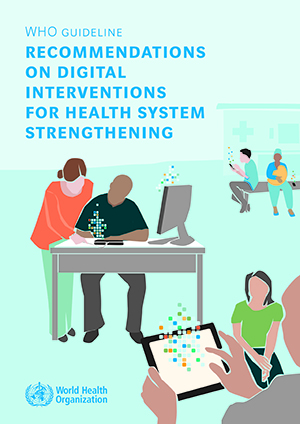International Health Faculty Key Contributors to First WHO Guideline on Digital Interventions for Health Systems Strengthening
The World Health Organization (WHO) recently released its first-ever guideline on digital health. The guideline includes 10 recommendations on ways digital health technology, such as mobile phones and tablets, can be used to improve people’s health and essential services. The recommendations are based on 2 years of extensive evaluation of the evidence in consultation with experts from governments, academia, implementation agencies, and multilateral organizations from every region around the world.

“This WHO guideline is more than a milestone in the field of digital health,” says Alain Labrique, PhD, MHS, MS, an associate professor in International Health at the Bloomberg School. “It provides a roadmap for research and a call for more high-quality evidence. The guideline’s recommendations are an inspiration to implementers to use digital health strategies to solve persistent health systems problems, especially for vulnerable and disadvantaged populations, on the road to universal health coverage.”
Labrique co-chaired the WHO Guideline Development Group, which reviewed and approved the final guideline. The Group also examined and interpreted the evidence and formulated the final evidence-based recommendations.
“While aspirational, the guideline offers practical insights on implementation considerations that should be taken into account in developing and scaling up digital interventions,” adds Smisha Agarwal, PhD, MPH, MBA, a new assistant professor for digital health in the Department who was also a member of the Development Group in her role at the Population Council.
The recommendations cover topics such as birth notification via mobile devices, digital tracking of patients’ health, and training of health workers via mobile devices. For each recommendation, a summary of the evidence on the effects of the intervention is given, its acceptability and feasibility, the equity, gender and human rights impacts, and the available resources for implementation.

The 10 recommendations are not meant to replace the fundamental parts of the health system, such as health workers. Instead, they should complement and enhance important functions, such as data collection, service provision and training. Their overall aim is to equip health policymakers and other stakeholders with recommendations for making informed investments into digital health interventions.
“Digital interventions depend heavily on the context and ensuring appropriate design,” cautions Garrett Mehl, PhD, MHS, an International Health alumnus who spearheaded the WHO Guideline as a lead coordinator and scientist in WHO’s Department of Reproductive Health and Research. “This includes structural issues in the settings where they are being used, available infrastructure, the health needs they are trying to address, and the ease of use of the technology itself.”
The guidelines are a culmination of a decade-long investment in digital health by the WHO. During that time Hopkins faculty, under the leadership of Labrique and his team at the Global mHealth Initiative, have provided critical technical assistance to WHO. And, they have helped produce crucial documents facilitating the development of these new recommendations. These include mHealth Evaluation, Reporting and Assessment (mERA) guidelines, Mobile Technology in Support of Frontline Health Workers, and The MAPS toolkit: mHealth assessment and planning for scale.
Several others affiliated with Hopkins were also involved in the development of the new recommendations. Alumni and Associate Faculty Subhash Chandir and Amnesty LeFevre and alumni Lavanya Vasudevan and Patty Mechael were members of the WHO Guideline Development Group. Associate Scientist Bill Weiss was a member of the External Review Group. The complete recommendations are available online from WHO.
For additional information, watch the e-seminar by Drs. Alain Labrique and Smisha Agarwal – A Review of the WHO Guidelines on Digital Health: Process and Next Steps
